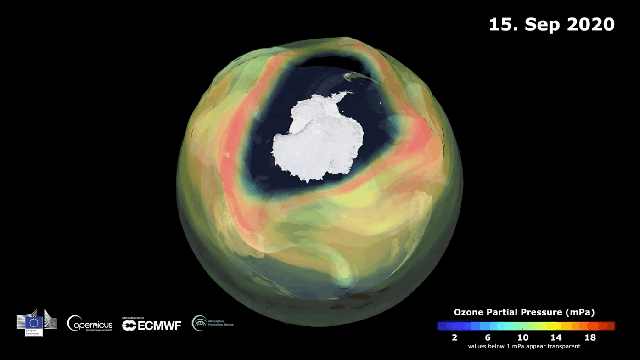If you’ve been looking to cast yourself into a deep hole from which you can never return (I have!), the one in the ozone layer is a prime choice right now.
The hole in the atmosphere’s ozone layer just reached its maximum annual size, experts at European Union’s Copernicus Atmosphere Monitoring Service (ECMWF) said on Tuesday. The extent of the hole over Antarctica reached 23 million square kilometres this year, making it one of the largest and deepest ozone holes in recent history. For context, that’s more than twice the size of the entire U.S. Throw me in!
The ozone is the part of the planet’s atmosphere that absorbs most of the dangerous incoming ultraviolet radiation from the sun. But humans’ penchant for using ozone-depleting substances for refrigeration and air conditioning caused a hole in that layer to open up annually each year. The alarming growth of the hole led world leaders to ban the ozone-depleting chemicals in the 1980s, but the ozone hole is still a huge problem that will take decades to totally heal.
The ozone hole forms when sunlight comes to the Antarctic region, and the light reacts with the ozone-depleting compounds that society has emitted over decades and have soared up into the freezing cold stratosphere. When conditions up in the atmosphere are particularly icy, this chemical reaction thrives. And this year, it got really, really cold due to a particularly strong polar vortex over the Antarctic.
It’s typical for the hole to fluctuate in size with weather events, but it generally becoming largest in October. But just because it happens every year doesn’t mean it’s good. 2020’s maximum extent was bigger and deeper than average.Vincent-Henri Peuch, director of Copernicus Atmosphere Monitoring Service at ECMWF, said in a statement that it resembled the relatively big and deep hole seen in 2018.
But weirdly, this year’s Big Hole followed last year’s small extent. In fact, last year’s ozone hole was the smallest minimum on record and it closed up relatively quickly.
“There is much variability in how far ozone hole events develop each year,” Peuch said. Clearly!
Despite the bad news about this year’s ozone hole, the overall picture is a little more rosy. United Nations research shows that the ozone hole is slowly but surely getting smaller. To fully heal the ozone layer and protect all life on Earth from dangerous levels of ultraviolet radiation, we’ve urgently got to stop putting chemicals into the atmosphere that mess with the ozone. A key way to do that is to ensure everyone in the world is adhering to the UN agreement known as the Montreal Protocol, under which nations pledged to rapidly phase out of using those chemicals altogether. The treaty is one of the most successful international environmental agreements in history, but this year’s ozone hole is a reminder there’s still work to do.
